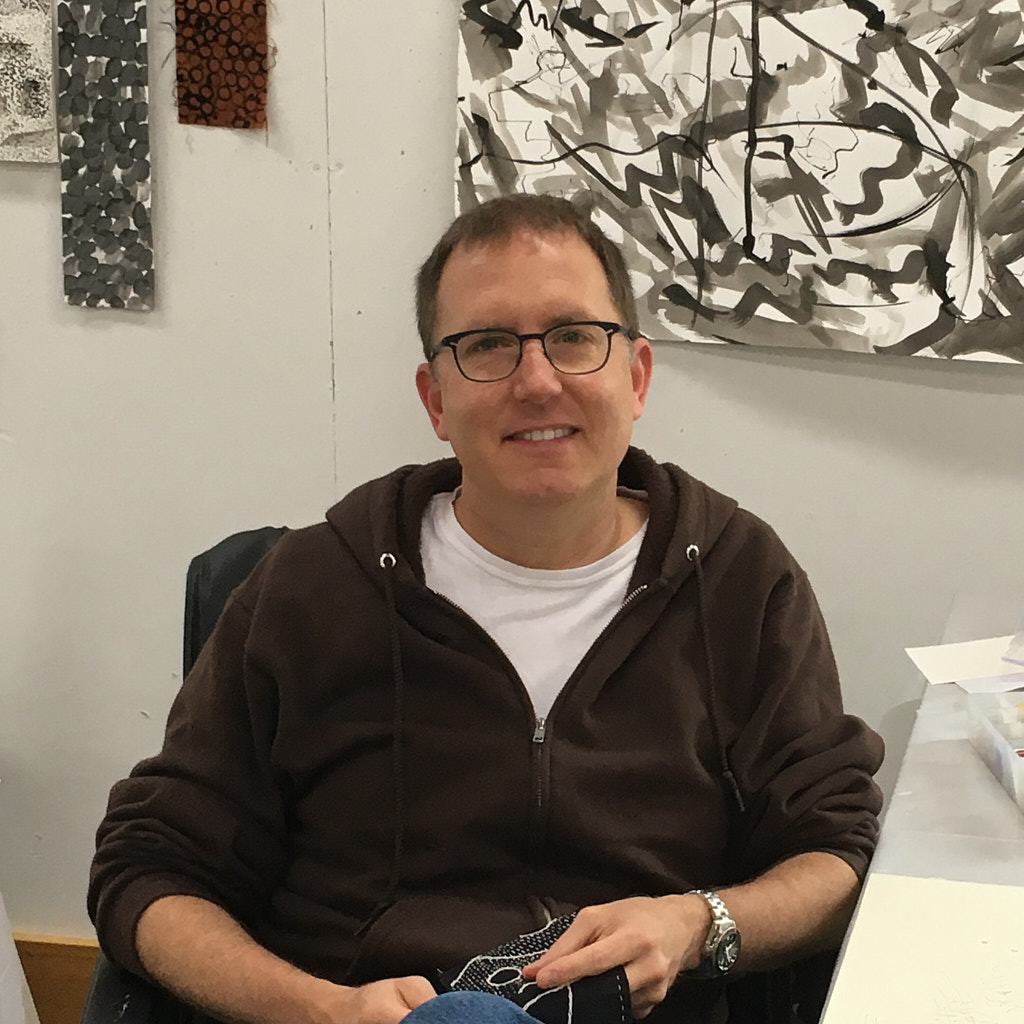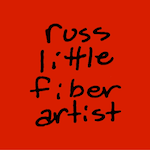
Artist bio
 Russ Little is an artist, and fiber is his chosen medium.
Russ Little is an artist, and fiber is his chosen medium.
His university education focused on the technical aspects of geography and cartography, and he spent more than 25 years applying that learning to a corporate career in print publishing and IT management. In his mid-40’s he had what he describes as, “an embarrassingly stereotypical midlife crisis” and entered a process of discernment that led him to recognize, name, and embrace his other identity as an artist. Over the past 15 years he’s studied surface design, dyeing, color theory, and 2D design in intensive workshop settings as he gradually made the transition to becoming a full time studio artist.<
Russ’s artwork is abstract, intuitive, and influenced by his interests in matters of faith, biology, computer programming, cartography, and the nature of places. It has been shown across the US in highly sought after juried exhibitions such as Quilt National, Quilts=Art=Quilts, Art Quilt Elements, and Artist as Quiltmaker. His artwork can also be found in private collections, and his liturgical textiles are part of the collections of several churches and clergy members. For several years Russ’s studio practice also included creating and selling original hand dyed wearable art scarves. In 2024 Russ began an ongoing exploration of weaving and spinning and he has begun incorporating his own handwoven cloth into quilted fine art compositions.
Russ is a member of the Surface Design Association (SDA), Studio Art Quilt Associates (SAQA), and Art Cloth Network (ACN) a juried group of textile artists committed to creating, exhibiting, and promoting works made of or referencing cloth. He is a past Chair of ACN and his work has appeared in over 16 of the group’s traveling juried exhibitions and catalogs.
He has been an invited speaker and workshop leader at artist groups and guilds. In 2024 he was a featured artist on the website Create Whimsy https://createwhimsy.com/projects/spotlight-russ-little-fiber-artist
Artist statement
My artwork is abstract and deals with the themes of brokenness, wholeness, connection, and movement through the juxtaposition and manipulation of color, shape, line, and layering. Circular forms speak to me on a soul-deep level and appear in most of my work. I work very intuitively. Rather than executing a carefully preconceived plan, I work in a call-and-response manner, allowing each new layer or design element to influence my next step. As such, I often only understand the meaning of a piece of art as it nears completion. Others have said that my work has mid-century modern, analytical, dreamy, and painterly qualities.
I work with all sorts of tools and media, but most of my work finds its completion as quilted fiber art. I’m a dyer, printmaker, programmer, photographer, painter, stitcher, weaver, spinner, and quilter. And, at the end of the day, I’m an artist.
I tend to create multiple works in a series. Doing so allows me to explore a given concept or motif more deeply by addressing it in several works of art. These pieces are sometimes created one after another and sometimes years apart, but they always relate to the same common theme.
My work has evolved into what I’m calling “quilted paintings,” as opposed to art quilts. These are whole cloth or pieced compositions created by either painting directly on cloth with dye or paint, or by printing a design on cloth using a wide carriage inkjet printer. The computer-based prints are made from iPad drawings or photographs of my own original paintings and collages on board or paper. The final product is layered with batting and backing, then quilted. I often add hand embroidered detail. For me, the quilting lines are the final drawing layer, adding texture and shadow to an otherwise flat surface. Not surprisingly, my quilting style often resembles contour lines on a map. It’s not an intentional thing; it’s just what happens when I sit down to quilt. It touches on my roots as a cartographer, and that sort of connectedness and authenticity is what I strive for in my work.
My four most recent or ongoing series are:
Reformation: a no-holds-barred revisiting of some of my older completed pieces. These finished works are getting cut, painted, combined, reassembled, and radically transformed. It’s about mining the past to create something new. It’s about evolution and reformation.
Mental Scribbling: a series that began as scribbles and intentionally messy erasures made on an iPad when, due to events in my life, that was all I was capable of doing. As the series evolved, I could see evidence of my life returning to something close to what it was before the Covid-19 pandemic.
More Than Black & White: a series that is both an exploration of limited hue compositions and a meditation on the events that occurred during the summer of “Black Lives Matter” protests.
Interaction: a series of far-ranging compositions exploring work methods and how they interact with the design.
Russ Little
College Park, MD
December 2024
